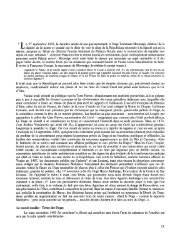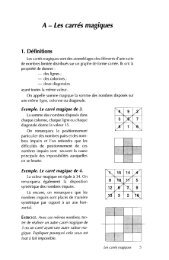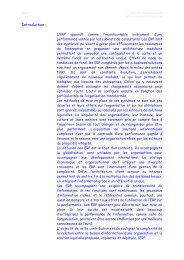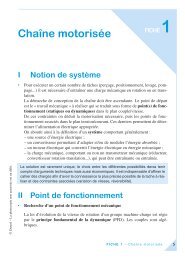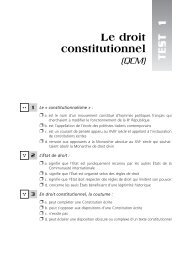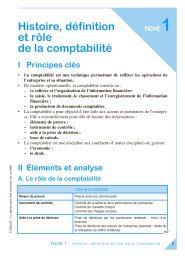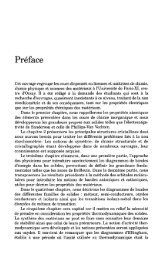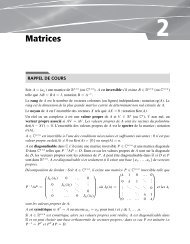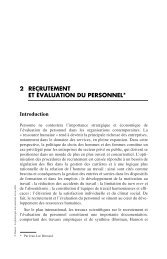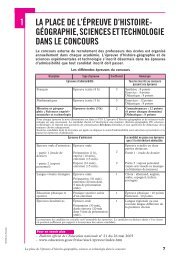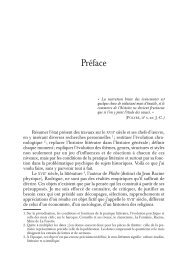You also want an ePaper? Increase the reach of your titles
YUMPU automatically turns print PDFs into web optimized ePapers that Google loves.
Fiche 1 • <strong>La</strong> <strong>quantité</strong> <strong>de</strong> <strong>matière</strong><br />
* Calcul du volume d’une <strong>quantité</strong> <strong>de</strong> <strong>matière</strong><br />
On définit pour cela le volume molaire : volume d’une mole d’entités, notée V m en L.mol –1 .<br />
V = V m × n<br />
V : volume <strong>de</strong> l’échantillon (L)<br />
n : la <strong>quantité</strong> <strong>de</strong> <strong>matière</strong> (mol)<br />
V m : volume molaire (L.mol –1 )<br />
Tous les gaz ont le même volume molaire V m . Par exemple, à T = 0 °C et P = 1,013 bar<br />
(conditions normales <strong>de</strong> température et <strong>de</strong> pression), V m (gaz) = 22,4 L.mol –1 .<br />
3. EN PRATIQUE…<br />
c Déterminons la <strong>quantité</strong> <strong>de</strong> <strong>matière</strong> correspondant à 1,5.10 24 molécules <strong>de</strong> sulfate <strong>de</strong> cuivre<br />
hydraté CuSO 4 , 5 H 2 O.<br />
N<br />
1,5.10<br />
n(CuSO 4 , 5 H 2 O) = ------ c’est-à-dire : n(CuSO 4 , 5 H 2 O) = ---------------------<br />
24<br />
6,02.10 23<br />
N A<br />
n(CuSO 4 , 5 H 2 O) = 2,5 mol<br />
Déterminons la masse <strong>de</strong> cet échantillon :<br />
m(CuSO 4 , 5 H 2 O) = n(CuSO 4 , 5 H 2 O) ¥ M(CuSO 4 , 5 H 2 O)<br />
Ne pas oublier les 5H 2 O dans le calcul <strong>de</strong> la masse molaire.<br />
Ainsi, m(CuSO 4 , 5 H 2 O) = 2,5 ¥ 249,6 = 6,2.10 2 g.<br />
c Maintenant, cherchons combien il y a <strong>de</strong> molécules <strong>de</strong> butane C 4 H 10 dans un flacon <strong>de</strong><br />
25 mL dans les conditions normales <strong>de</strong> température et <strong>de</strong> pression (V m (gaz) = 22,4 L.mol –1 )<br />
N = n(C 4 H 10 ) ¥ N A<br />
V<br />
Or, n(C 4 H 10 ) = ------- donc N = -------<br />
V<br />
¥ N A<br />
Ainsi, N =<br />
25.10<br />
-----------------<br />
–3<br />
22,4<br />
V m<br />
¥ 6,02.10 23 = 6,7.10 20 molécules<br />
c Enfin, calculons la <strong>quantité</strong> <strong>de</strong> <strong>matière</strong> d’aci<strong>de</strong> ascorbique contenu dans un comprimé <strong>de</strong><br />
vitamine C, contenant 500 mg d’aci<strong>de</strong> ascorbique C 6 H 8 O 6 .<br />
mC (<br />
n(C 6 H 8 O 6 ) = 6 H 8 O 6 )<br />
------------------------------<br />
MC ( 6 H 8 O 6 )<br />
V m<br />
500.10<br />
Ainsi, n(C 6 H 8 O 6 ) = --------------------<br />
–3<br />
= 2,84.10 –3 mol.<br />
176,0<br />
3




